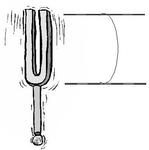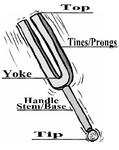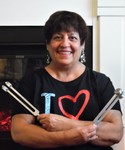Tuning Fork TherapyŽ
About Tuning Forks and Tuning Fork TherapyŽ
Below is some basic information and my personal thoughts as to the use, benefits and contraindications of a healing session using tuning forks.
What is a Hertz?
In the case of tuning forks, sound is measured in movement or vibrations. This movement is referred to as Hertz or Hz for short and was named for the man who invented the term, Heninrich Rudolph Hertz and represents one vibration per second.
The number listed on each of the tuning forks is in Hz and correlates to the rate of vibrations per second that the tuning fork is associated with. The lower the number listed on the tuning fork, the slower the vibrations per second. See the diagram below.
A Tuning Fork vibrating 1 time each second would have a frequency of 1 Hz.
Benefits of a Tuning Fork TherapyŽ Session
In addition to using tuning forks to tune musical instruments, they are also being used in physics classrooms across the country to teach students about sound, vibration and sound waves.
In the medical field, tuning forks such as the C-512 Hz were used by health care practitioners to make assertations of a patient’s hearing. (Experts123)
While the higher tuning fork frequencies checked for hearing loss, other lower sounding tuning forks, such as the C-128 Hz, were used to check vibration sense generally as part of the examination of the peripheral nervous system. In some parts of the world, tuning forks have since been replaced by machinery to perform these same tasks.
The tuning fork was first invented in 1711 in England by Royal Sergeant Trumpeter to the court and lutenist, John Shore. At the time, he jokingly called it a pitch fork. It was made of steel and had a pitch of A423.5.
But the thoughts and beliefs about tuning forks can be traced much further back in time; All the way back in fact to the early Greeks.
In 583 B.C., the Greek philosopher, Pythagoras, made a device called the monochord and set the pitch to 256 Hz. The Greek and Egyptians used the monochord to make intricate mathematical calculations.
Other uses for sound and vibrations began to surface. In 1550 Pacia, Italy, the physician, mathematician and astrologer Girolamo Cardano, noticed how sound was being perceived through the skin.
Just three years later, in 1553 Paua, Italy, H. Capivacci, a physician noticed that this knowledge of sound that was being perceived through the skin might be used as a diagnostic tool for differentiating between hearing disorders located in the middle ear or the acoustic nerve. (Many people living today can remember having their hearing tested by a doctor holding a tuning fork.)
In the 18th century the German physicist Ernest Chladni, discovered that when a violin bow was drawn vertically across the rim of a metal plate, the sound waves it produced created patterns in the sand that was sprinkled on the plate. For each different musical tone that was played, the sand particles formed a different geometric pattern.
In the late 1960s, the Swiss scientist Hans Jenny discovered that the low frequency sounds produced simple geometric shapes and as the sound frequency increased, the shapes become more complex. He also found that the sound ‘OH’ produced a perfect circle and that the sound ‘OM’ produced a pattern similar to that of the ancient Indian mandala for ‘OM.’
In 1974, a professional jazz musician named Fabien Maman noticed that by playing certain musical notes he could have an energizing effect on the audience.
In the late 1970s, Fabien joined with the senior researcher at the National Centre for Scientific Research in Paris, Helene Grimal, to study the effects of sound on normal and malignant cells.
The pair used all types of sound making instruments including flutes, drums, gongs and more. They discovered that at 30-40 decibels, the sound always produced changes in the cells and that the higher up the musical scale they went, the frequency would travel outward from the center of the cell to its outer membrane. The most amazing results happened when the human voice was used.
In an experiment on female volunteers with breast cancer, women were taught to tone the whole scale using a violin to keep a base note for 21 minutes at a time. They spent 3 ½ hours a day for one month toning. One woman’s tumor disappeared completely (The Healing Power of Sound, 2014).
On the cellular level, Fabien Maman found that the note ‘C’ made the cells longer, that the note ‘D’ produced a variety of colors in the cells; the ‘A’ note changed the color of the cell’s energy field from red to pink, and that the note ‘E’ made the cells spherical. Maman also noticed that the note ‘F’ made the cells round, balanced and with vibrant colors of magenta and turquoise. He also noted that the ‘F’ note was the fundamental sound of the singer and believed that this was helpful for the physical body through its harmonizing and regenerating effect at the cellular level. (5)
The Japanese scientist, Masaru Emoto, discovered that music affected water and that different types of music affected it in different ways. While he found that classical music, folk music and mantras produced beautiful crystals and colors; heavy metal music produced patterns that appeared exploded and shattered.
With our bodies made up of more than 60% water, Emoto’s work demonstrated the importance of how our body is influenced by the sounds around us and by the information stored in the water that we drink.
In his book, The Mozart Effect, Don Campbell showed how music has beneficial effects for human health. From improving concentration to enhancing our intuition, music can affect our bodies.
Slow tempo music slows the heart rate and breathing patterns. It calms our nervous systems and even affects our metabolism. Music can also effect our emotions. Campbell found that by playing music in the dentist’s office or operating room, patients were better able to remain calm.
Dr. Tomatis used high frequency sounds (3,000 Hz. and above) to activate the brain and affect cognitive functions such as thinking, spatial perception and memory. Listening to these sounds increases our attentiveness and concentration. (2)
In his book The Healing Power of Sound, Mitchele L. Gaynor, M.D. suggests that practitioners need to combine sound with imagery to achieve optimum success.
But in his book on sound, Healing Sounds, Jonathan Goldman suggests that we practitioners need to use sound and intention to achieve healing-he goes on to say that sound without intention does not heal.
Barbara Hero and the International Lambdoma Research Institute in Kennebunk, Maine, discovered that by passing sound waves through each organ of the body that they were able to calculate the optimal frequency for each of the organs using mathematical formulas based on the speed of sound.
Tuning forks are also used in a therapeutic therapy called Sonopuncture. John Beaulie, a well-known modern day researcher on the therapeutic benefits of tuning forks, has spent many years accumulating the effects and affects of sound on the human body. As part of his research, Beaulieu recorded an album of music made entirely with tuning forks, called Calendula.
Other researchers into the therapeutic benefits of tuning forks include Arden Wilken and Jack Wilken, and of course-me.
Parts of the Tuning Fork
Take your tuning fork in your hand and look at the different parts of the instrument. The very top of the tuning fork is called the top. The two long sides of the tuning fork are called prongs or tines. They are responsible for creating the vibrations of your tuning fork. Follow these two prongs down you will come to a U-shaped part of the tuning fork that we call the yoke.
The bottom part of the tuning fork is called the stem, or handle. This is where you hold your tuning fork to activate it. The very end of the handle is sometimes called the ‘Tip’ of the tuning fork. So when I say to place the tip of the tuning fork on the body, this is the part that you will be using.
What things can affect your Tuning Fork
The largest effect on tuning forks is the temperature. The pitch of the tuning fork can drop one percent for every eight-degree rise in temperature Fahrenheit. This can occur most easily in the northern states where you may take your tuning forks from your climate-controlled home, into your cold car, from the now warm car and through the cold air, back into another climate-controlled area (or forget about them and leave them in the cold (or hot) car for several days). These things happen, and you should know that they will affect the pitch of your tuning forks either immediately or over time.
If you use steel tuning forks, they suffer more from changes than do most tuning forks made from aluminium alloy as they will also patene over time which will definitely change the pitch and tone.
Precautions and Contraindications
Until further studies are done in using tuning forks, I would NOT use tuning forks on the following groups of people:
- Those with pacemakers (in area of heart)
- Metal implants, pins or other metal bindings (if they are made of steel avoid that area. Other metals seem to be okay)
- Pregnant women (avoid abdominal area)
- Stents, inserted tubing, etc. (avoid area of insertion) Please use caution here as vibrations may cause object to become dislodged and can affect your client adversely.
- Colonoscopy bag, catheters, etc. (avoid area)
- Aneurisms, blood clots, etc. (avoid area)
Please note that is my own feeling on the subject, which may or may not be found to be true. I have always believed that if you should err; err on the side of caution.
How to Properly Store your Tuning Forks
Store your tuning forks in a clean and dry place. Pitch varies with temperature, so try to keep your tuning forks stored at the same moderate temperature. Should condensation occur due to cold weather, it may cause corrosion or discoloration of your tuning forks. Excessive force should not be used when toning.
Always use a rubber mallet, the palm of your hand, a tuning fork activator, the front muscle on the top of your leg, a rubber hockey puck, or even the rubber heel of a boot as a striking place for your tuning forks. DO NOT clean your tuning forces with detergent, ammonia, or other chemicals
You can store your tuning forks in the wooden box or in the canvas wrap-around they came in. I store one set of my tuning forks in an upright position in a block of wood into which holes have been drilled.
I purchased this block of wood on-line, but if you are creative enough, you can make your own by drilling holes into a simple scrap piece of wood. I have found this to be handy for times when I need to hear a quick tone.
Copyright 2021 Francine Milford
Difference in Tuning Forks
Take a look at the two tuning forks in the picture below. These two forks are both Middle C (256 Hz). By looking at them, you could expect that the sound emitting from these two forks would be very different. But they are not. Although the material make up of the fork itself will affect the loudness or sharpness of sound, the frequency will still be the same. And thus, so will be the benefits.
In the picture above, the fork on the left is the newer version on the market. A set of these “Harmonic Forks” usually contain 7-8 tuning forks and run approximately $150. The fork on the right is part of an 8 piece set that comes with a rubber mallet and sells for around $50. This set is used in science classes to teach children about sound waves. I own and use both sets and see value in both of them. I use the less expensive set on pets, children, and sensitive (or very ill and weak) adults. The others I use on body or energy workers.




